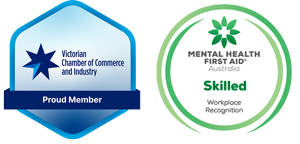
Tips for onboarding employees who are working from home
We all understand that the impact of the COVID-19 pandemic to Australian businesses has been unparalleled. Government restrictions implemented to slow the spread of this infectious disease have resulted in changes that most of us (fortunately) haven’t witnessed in our lifetimes. At a minimum, businesses have needed to adjust (or in some cases ‘overhaul’) their processes and how they operate, including allowing working from home. In contrast, others have had to either reduce their services offered or sadly, in some cases, close their doors altogether.
Due to the uncertainty of what the future holds, businesses may be reluctant to continue with plans for growth. Many have put a temporary ‘freeze’ on recruitment plans for the foreseeable future. However, not every industry is in the same boat and for some, continuing with the recruitment of critical roles is essential.
Supermarket giants Coles and Woolworths advertised 25,000 new positions between them in April 2020 to keep up with the increased demand for groceries. One of our HR clients MSAC Solutions (MSAC), a regionally based company that provide managed services and consulting for supermarkets and food manufacturing companies, is continuing to provide ‘service as usual’ while working remotely. Recently, due to winning new work, this included a critical recruitment drive for new employees to manage and assist on a project.
Having worked with international clients in the UK, USA and France for many years, MSAC has always used technology to communicate and manage their business in a global market. However, recruiting and onboarding new employees in a completely virtual way hasn’t been without its challenges.
What legal considerations should you make when new employees are working from home? What technology systems/platforms can assist you in training new employees? How can you ensure that your new employees don’t feel isolated and still experience the organisation’s culture? These are all questions that businesses will be asking as we adjust to the new normal of employment.
Here are our tips for onboarding employees who are working from home during the current climate.
1. Implement a Working from Home (WFH) Agreement
We recommend that employees who will be working from home have a WFH agreement that clearly states the responsibilities and expectations while working remotely.
As a first step, employers should check the industrial instrument (Enterprise Bargaining Agreement or Award) that applies to ensure compliance with all terms and conditions.
A WFH Agreement may include communication with their manager and team (who do they need to contact regularly, how and when?) as well as the employee’s specific obligations around the security of company information. For example, the employer may request that the employee take extra precautions to manage confidential information, such as a locked filing cabinet. Ideally (albeit understandably difficult during the pandemic) working from home should not be a replacement for childcare. Therefore appropriate care or support for any children at home should still be arranged during work hours.
A WFH agreement should also state that the employer will review the arrangement on an ongoing basis and can revise the arrangement at any time. It should not be a case of set and forget, particularly in a rapidly changing climate and the uncertainty of when restrictions may be eased or lifted entirely.
2. Ensure safety is still a top priority
When employees are all working in one location, it is easier to control potential hazards and keep an eye on their overall wellbeing. When working from home, employers have substantially less visibility. Workplace health and safety laws still apply when an employee is working from home. Therefore, any injury an employee suffers while performing their duties at home has the potential to become a worker’s compensation claim.
Employers should first consider the nature of the work to be performed and the suitability of the employees’ home. As part of a WFH Agreement, employers should require employees to self-assess their work area by completing a Work Health & Safety Checklist and make modifications if needed.
The checklist should cover a range of potential hazards and may also require the employee to submit photos of their work area for the employer to review. It is crucial not only to consider the immediate work area but whether the home has items such as a smoke detector and a first aid kit.
After reviewing the checklist and photos, if the employer considers any aspect of the home unsafe, they should not allow the employee to work at home without modifications. Employers could also consider supplying or loaning office furniture such as ergonomic chairs or other relevant equipment.
Lastly, employers should not overlook the potential impact on an employee’s mental health when they are working from home. Working in isolation may be a significant change for some and therefore reiterating available support networks, including Employee Assistance Programs, will be beneficial.
3. Use technology to your advantage
In 2020, emails and phone calls can be considered ‘outdated technology’. There are many online collaboration and communication platforms available, which allow team members to work together both in real-time and ‘face to face’ – almost as if they are working in person.
Not only is videoconferencing efficient, but a great tool to ensure participants in meetings remain engaged in conversations. It is also useful for employee training sessions, which is particularly crucial for a new employee with a lot to learn in their first few weeks. Some platforms will also have the capability to host webinars with multiple participants. At Strawberry Seed, we use Zoom. However, there are many systems available to teams, including Skype, Google Hangouts Meet and Microsoft Teams.
When COVID-19 started to emerge, and the prospect of working from home looked more and more likely to be a measure to ‘flatten the curve’, MSAC chose to use Microsoft Teams. Managing Director, Andy McKie, shared that it was “adopted quickly and easily by their teams and became the bedrock for working remotely and maintaining internal collaboration”.
Microsoft Teams has a combination of a videoconferencing and a real-time chat. This has allowed the MSAC employees to stay connected through one-on-one and group messaging, face to face team meetings and the ability for team members to share their work via screen sharing. MSAC even conducted their recruitment process via Microsoft Teams, which introduced candidates to the company’s systems from day one. Andy added that using the system for recruitment was a “perfect filter” to determine if candidates could quickly embrace the MSAC way of working remotely.
Don’t underestimate the value of a real-time chat application as it allows teams to communicate smoothly and seamlessly. They are particularly valuable for new employees who may need to troubleshoot matters by asking their manager and team members questions as they arise. A time-saving alternative when compared to scheduling a meeting or waiting on an email reply.
At Strawberry Seed, we use SLACK, which, in addition to direct messaging, allows us to divide content into ‘channels’. This keeps conversations on one topic or client in one space, and everyone can see discussions, even if they are not involved. One of the most significant advantages of direct communication tools is that it can reduce the number of unnecessary emails in your inbox!
4. Communicate clearly and regularly
An effective communication strategy is paramount to cultivating high performing workplaces. It is even more critical while working remotely. New employees need to understand their goals, work processes and what’s expected of them on a day to day basis. Managers must ensure they are still scheduling regular one on one meetings with their team, but new employees need to be the priority.
MSAC has prioritised embedding regular manager/employee one to one meetings into their daily practice, where they “talk about their culture and expectations”, which had led their employees to have more accountability for their work.
If new employees begin working remotely, it is not the time to under-communicate. The exact opposite is needed. Before new employees commence, you need to have a communication strategy. Consider what will help the employee to be effective from day one.
To assist with the induction and communication of company information for new employees, MSAC has created an extensive ‘Welcome and Onboarding Manual’. Designed to help to set the employee up for success, it describes the company expectations from the day they begin work, all the way through to their first three months. It also outlines its company’s history and culture. Andy acknowledges that “Constant communication can feel exhausting, however knowing expectations of each other is the key. So many expectations can be unspoken and not shared. So it’s important to be deliberate in open, honest communication. Tough conversations are easier if communication is frequent and done with the aim of building trust”.
5. Promote a sense of community
MSAC understands that the long-term success of their business is driven by embedding a culture of connectedness and trust. They have worked hard to instil a team-orientated culture, where employees can come together in the one location to interact and provide professional feedback to one another. Andy shared that while “there is the possibility that this may become diluted somewhat when employees are not together physically over a long period, there are still opportunities to promote personal interactions and a sense of community while working remotely”.
Celebrating achievements, successes, and personal events such as birthdays can still be maintained via videoconference. These create stronger bonds amongst colleagues, particularly for a new employee who is getting to know everyone for the first time.
Regular social interactions can help them feel a sense of belonging with their new employer and team. At Strawberry Seed, we have regular Zoom meetings that are not related to work. These include virtual morning tea and even late-night wine catch-up after everyone’s kids had gone to bed (alcoholic beverage optional of course!).
It is also vital for managers to keep each team member in mind when making decisions around the delegation of work. As they are not in close (physical) contact each day, it may be easy for the quieter or more introverted person to be overlooked (however they probably love the forced alone time right now).
MSAC approaches this by recognising that “each employee is different and their situation may be different too”. Andy states that “to be successful, our managers must adapt to the personality and communication styles of all our employees”. He adds “this allows them to develop personalised strategies to help new employees, not only in how to do their role but more importantly to feel engaged as valued members of the team, with important contributions to be made”.
As a business owner, you may be feeling overwhelmed when it comes to managing your team. We can help with your HR obligations during this period of change and uncertainty. At Strawberry Seed, we can provide tailored HR advice, specific to your business needs.



